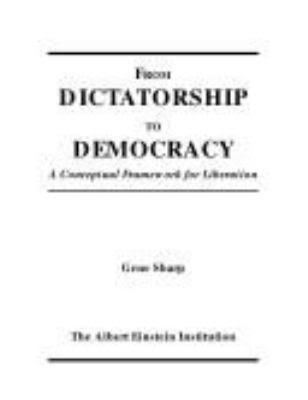Language English & 30+ others Published in English 1994 OCLC 706499601 Page count 93 | Publication date 1994; others Pages 93 (2010); others Originally published 1994 Country United States of America ISBN 9781880813096 | |
 | ||
Publisher Albert Einstein Institution Similar Gene Sharp books, Nonviolence books | ||
From dictatorship to democracy by gene sharp full audiobook greatest audio books
From Dictatorship to Democracy, A Conceptual Framework for Liberation is a book-length essay on the generic problem of how to destroy a dictatorship and to prevent the rise of a new one. The book was written in 1993 by Gene Sharp (b. 1928), a professor of political science at the University of Massachusetts. The book has been published in many countries worldwide and translated into more than 30 languages. Editions in many languages are also published by the Albert Einstein Institution of Boston, Massachusetts. As of 2012 its current primary English-language edition is the Fourth United States Edition, published in May 2010.
Contents
- From dictatorship to democracy by gene sharp full audiobook greatest audio books
- From dictatorship to democracy full audiobook
- Origin
- Topics covered
- Influence
- Editions
- References
The book has been circulated worldwide and cited repeatedly as influencing movements such as the Arab Spring of 2010–2012.
From dictatorship to democracy full audiobook
Origin
From Dictatorship to Democracy (FDTD) was written in 1993 at the request of a prominent exiled Burmese democrat, Tin Maung Win, who was then editor of Khit Pyaing (The New Era Journal), in Bangkok, Thailand. The book took several months to write as the author drew upon several decades of experience in scholarship on nonviolent action. FDTD was first published in 1993 as installments in Burmese and English in Khit Pyaing. In 1994, it was issued as a booklet in both English and Burmese. Since that time, there have been several additional English-language editions and translations into more than 30 additional languages.
Topics covered
From Dictatorship to Democracy contains a preface and ten sections. Its first appendix includes 198 Methods Of Nonviolent Action that were taken from Gene Sharp's The Politics of Nonviolent Action (1973), Part Two, The Methods of Nonviolent Action. The main sections of the 4th US edition are entitled:
1. Facing Dictatorships Realistically2. The Dangers of Negotiations3. Whence Comes the Power?4. Dictatorships Have Weaknesses5. Exercising Power6. The Need for Strategic Planning7. Planning Strategy8. Applying Political Defiance9. Disintegrating the Dictatorship10. Groundwork for Durable DemocracyThree appendices are included in the fourth US edition of FDTD:
Appendix 1. The Methods of Nonviolent ActionAppendix 2. Acknowledgements and Notes on the History of From Dictatorship to DemocracyAppendix 3. A Note About Translations and Reprinting of this PublicationFor Further ReadingAppendix 3 gives a step-by-step procedure for effectively translating FDTD into other languages.
Influence
From Dictatorship to Democracy has been circulated worldwide and cited repeatedly as influencing movements such as the Arab Spring (pictured) in 2011. Sharp has stated that after FDTD was first written, "although no efforts were made to promote the publication for use in other countries, translations and distribution of the publication began to spread on their own.... We usually do not know how awareness of this publication has spread from country to country."
A CNN profile of Sharp in 2012 stated that FDTD had "spread like a virus," calling it a "viral pamphlet." The book "started life in Myanmar as incendiary advice printed on a few sheets of paper and surreptitiously exchanged by activists living under a military dictatorship." Later it "took on a life of its own... eventually, some say, inspiring the uprisings known as the Arab Spring."
The Pakistani Daily Times stated that FDTD "has had an impact on the Arabic-speaking world even though the setting is in a non-Arabic world."
The Financial Times, in discussing the prospects for dictators worldwide, described Sharp as "the Lenin of the new Gandhi-ism" stating that
What is new... is the wildfire spread of systematically non-violent insurgency. This owes a great deal to the strategic thinking of Gene Sharp, an American academic whose how-to-topple-your-tyrant manual, From Dictatorship to Democracy, is the bible of activists from Belgrade to Rangoon.
The BBC reported in 2004 that FDTD "was used practically as a textbook" in lectures attended by members of Otpor!, the Serbian resistance movement, in the year 2000.
The New York Times reported in 2011 that From Dictatorship to Democracy had been posted by the Muslim Brotherhood on its website during the 2011 Egyptian revolution.
In 2012, The New York Times noted that FDTD was "available for download in more than two dozen languages" (and provided a link), while describing Sharp as a "leading [advocate] of grass-roots democracy."
In June 2015, the Financial Times and Newsmax reported that the Chinese government had tried to buy language rights to FDTD:
[L]ast year [in 2014]... a [Chinese] state-owned publisher contacted the Boston-based Albert Einstein Institution about acquiring the Chinese-language rights to Gene Sharp's "From Dictatorship to Democracy" — a seemingly odd request at a time when tens of thousands of pro-democracy protesters had taken to the streets in Hong Kong, the newspaper notes.... [The Institution's Executive Director Jamila] Raqib thinks the publishers wanted to stop others from [printing the book] by "squatting" on the rights to it...
FDTD has been reviewed in newspapers.
In 2015, 17 activistists were charged for an attempted coup d'état in Angola, and one of the proofs presented was the possession of the book FDTD.
Editions
The book was first published in 1993 in installments in Burmese and English in Khit Pyaing in Bangkok, Thailand. In 1994, it was issued as a booklet in both languages, with the assistance of the Committee for the Restoration of Democracy in Burma. Since that time, there have been several additional English-language editions. There have also been editions in at least 30 other languages (see table at right). The English-language editions include:
